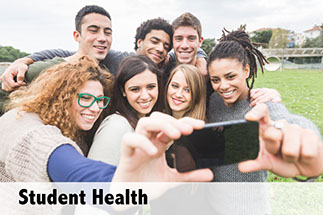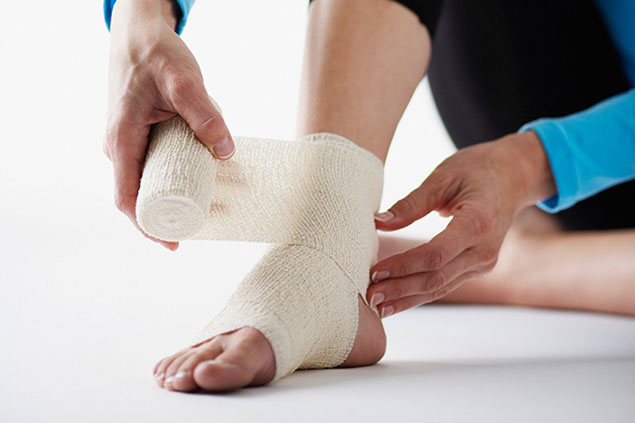CONDITIONS
SYMPTOM CHECKER
Male
Female
Child
Arm, Hand & Shoulder Concerns
Legs & Feet Concerns
Dental & Mouth Concerns
Ear & Nose
Eye Conditions
Head Conditions
Arm, Hand & Shoulder Concerns
Legs & Feet Concerns
Front
Back
Arm, Hand & Shoulder Concerns
Dental & Mouth Concerns
Ear & Nose
Eye Conditions
Head Conditions
Arm, Hand & Shoulder Concerns
Dental & Mouth Concerns
Ear & Nose
Eye Conditions
Head Conditions
Front
Back
Arm, Hand & Shoulder Concerns
Neck Links
Head & Neck Concerns
Arm, Hand & Shoulder Concerns
Neck Links
Head & Neck Concerns
Front
Back
Online Clinic
Wise Healthcare
Sprains, Strains & Sports Injuries
Print on Demand
For Sprains
A sprain happens when you overstretch or tear a ligament. (This is fibrous tissue that connects bones.) A joint is affected, but there is no dislocation or fracture. Symptoms are rapid pain, swelling, bruising, and a warm feeling at the injured site.
For Strains
A strain is an injury to the muscles or tendons. (These are tissues that connect muscles to bones.) Symptoms are pain, tenderness, swelling, and bruising.
Fishhook Removal
For Sports Injuries
Sports injury symptoms depend on the injury. They include pain, tenderness, swelling, and bruising. Bones may be broken or dislocated.
Causes
Sprains occur from an accident, injury, fall, etc. A strain occurs when you overstretch or overexert a muscle or tendon (not a ligament). This is usually due to overuse and injuries, such as sports injuries.
Treatment
Treatment for sprains, strains, and sports injuries depends on the injury and on the extent of damage. Self-care may be all that is needed for mild injuries. Sports injuries and sprains may need medical treatment. Some sprains need a cast. Others may need surgery if the tissue affected is torn.
Broken bones (other than broken toes) need medical care right away.
Questions to Ask
Question 1
Suspect a head, neck, or spinal injury by any of these symptoms?
• Loss of consciousness. Paralysis. The head, neck, or back can’t move. Neck pain is felt right away.
• Inability to open and close the fingers or move the toes or any part of the arms and legs.
• Numbness in the legs, arms, shoulders, or any body part.
• It looks like the head, neck, or back is in an odd position.
Get medical care without delay. If symptoms are life threatening go to the ER or call 9-1-1. Don’t call 9-1-1 or use the ER if symptoms do not threaten life. Ask your doctor ahead of time where you should go for a problem that needs prompt care, but not emergency care.
Question 2
Are any of these signs present?
• A bone sticks out or bones in the injured part make a grating sound.
• An injured body part looks bent, shortened, or misshaped.
• You can’t move the injured body part or put weight on it.
• The injured area is blue, pale, or feels cool, but the same limb on the other side of the body does not.
Get medical care without delay. If symptoms are life threatening go to the ER or call 9-1-1. Don’t call 9-1-1 or use the ER if symptoms do not threaten life. Ask your doctor ahead of time where you should go for a problem that needs prompt care, but not emergency care.
Question 3
Are any of these signs present?
• You can’t bend or straighten an injured limb.
• Bad pain and swelling occur or the pain gets worse.
• Pain is felt when you press along the bone near the injury.
You should be seen by your doctor for medical advice. Contact your doctor or health care provider to find out how soon you should be seen.
Question 4
Does the sprain or strain not improve after using self-care for 2 days?
Call your doctor or health care provider and state the problem. He or she can decide what you should do.
Use Self-Care / First Aid:
You can probably take care of the problem yourself if you answered NO to all the questions. Use the “Self-Care” measures that are listed. Call your doctor if you don’t feel better soon, though. You may have some other problem.
Self-Care / First Aid
• If the injury is not serious, stop what you are doing and use R.I.C.E.
• If you sprained a finger or hand, remove rings. (If you don’t and your fingers swell up, the rings may have to be cut off.)
• Take an over-the-counter medicine for pain, if needed. {Note: Many sports medicine providers do not recommend aspirin-like medicine at first, because it can make bleeding and bruising worse.}
• Try liniments and balms. These give a cooling or warming sensation by masking the pain. They do not promote healing.
• Once the injury begins to heal, use M.S.A.:
– Movement. Work toward a full range of motion as soon as possible. This will help maintain flexibility during healing and prevent any scar tissue from limiting future performance.
– Strength. Gradually strengthen the injured area once the swelling is controlled and a range of motion is back.
– Alternative Activities. Do regular exercises that do not strain the injured part. Start this a few days after the injury, even though the injured part is still healing.
To Prevent Serious Injuries (especially during contact sports)
• Wear the right protective gear and clothing for the sport (e.g., a helmet; shoulder, knee, and wrist pads; a mouth guard, etc.).
• Train in the sport so you learn how to avoid injury. “Weekend athletes” are prone to injury. Follow the rules that apply to the sport.
General Prevention
• Ease into any exercise program. Build up gradually.
• Avoid running on hard surfaces like asphalt and concrete. Run on flat surfaces. Running uphill puts added stress on the achilles tendon.
• Don’t lock your knees. When you jump, land with your knees bent.
• Wear shoes and socks that fit well. The widest area of your foot should match the widest area of the shoe. You should be able to wiggle your toes with the shoe on when you sit and when you stand. Wear shoes that provide shock absorption and stability.
• Stop if you feel pain. Don’t do the activity until you can do it without pain.
• Cool down after exercise. Do the activity at a slower pace for 5 minutes.
This website is not meant to substitute for expert medical advice or treatment. Follow your doctor’s or health care provider’s advice if it differs from what is given in this guide.
The American Institute for Preventive Medicine (AIPM) is not responsible for the availability or content of external sites, nor does AIPM endorse them. Also, it is the responsibility of the user to examine the copyright and licensing restrictions of external pages and to secure all necessary permission.
The content on this website is proprietary. You may not modify, copy, reproduce, republish, upload, post, transmit, or distribute, in any manner, the material on the website without the written permission of AIPM.
2021 © American Institute for Preventive Medicine - All Rights Reserved. Disclaimer | www.HealthyLife.com


















































